This post may contain affiliate links. Please read our disclosure policy.
This perfectly tangy and creamy cashew cream cheese is naturally cultured with probiotics! Just 2 ingredients are required to make the best vegan cream cheese! Use it in sandwiches, toast, and bagels, or use it to make sauces or dips!
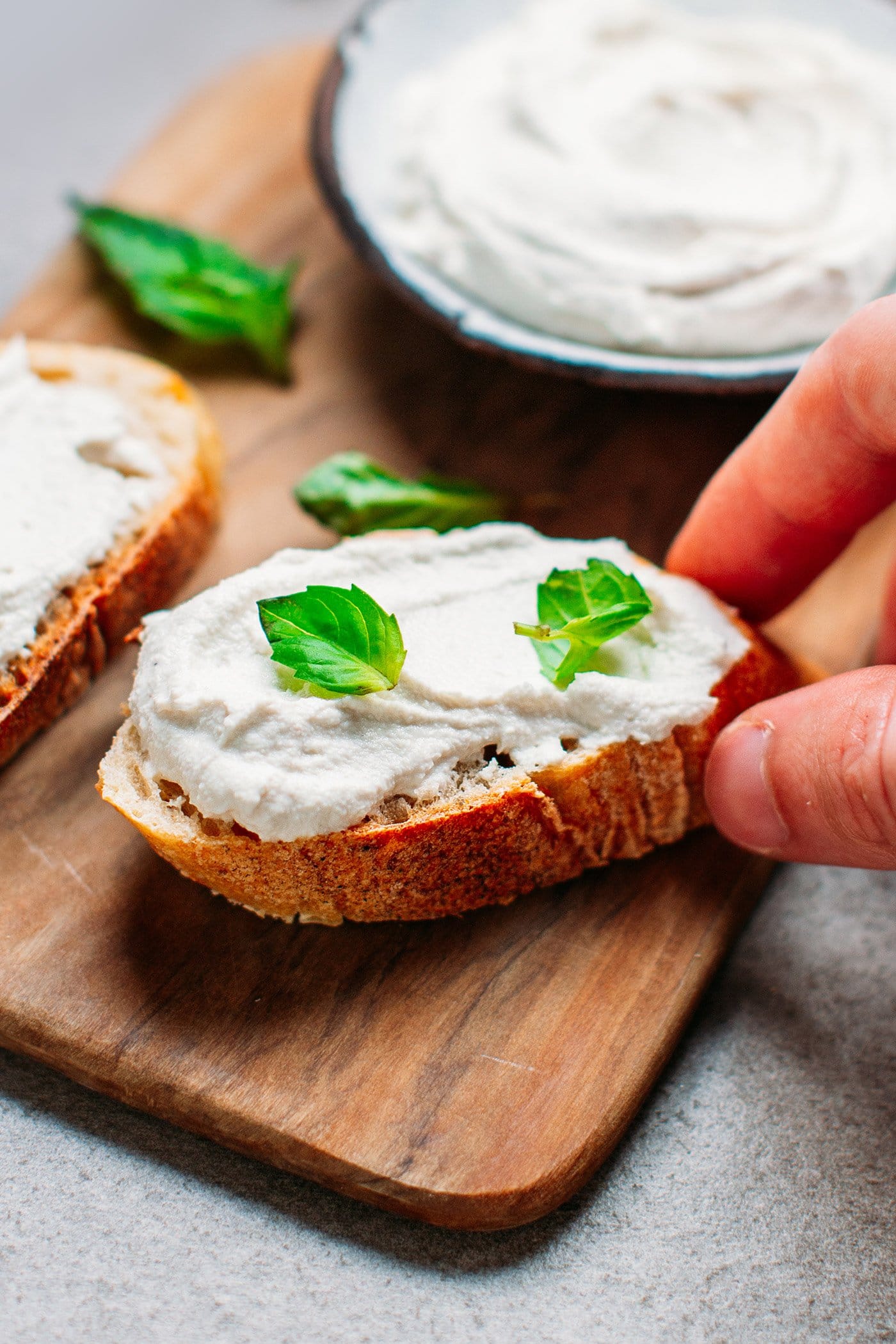
This cashew cream cheese is by far one of the recipes I have been making the most. The reason is that it’s super simple and tastes so much better than the store-bought alternatives.
My version relies on just 2 wholesome ingredients (okay, actually three if you count the water) and a natural fermentation process, resulting in rich, ultra-creamy, and tangy cream cheese.
The best thing about this recipe is that it’s versatile and can be used in a multitude of dishes. I love to use it on toast and bagels or as a base to make delicious pasta sauces (I’m looking at you, Alfredo sauce). Sometimes, I also combine it with herbs or spices to serve it as a dip when we have guests. Either way, I’m sure you are going to love my cultured cream cheese!
⭐️ Why You Should Try It
Easy to make with minimal ingredients.
If you have made my vegan blue cheese or hickory-smoked cheese before, you will feel right at home with this recipe. And if you haven’t, don’t worry – this one is actually much simpler than my aged cheese recipes. I would say it’s a 2/10 on the difficulty scale. Just blend cashews with water, stir in probiotics, and let it ferment. Nothing more!
Naturally cultured.
As opposed to other quick cream cheese recipes, mine is naturally cultured with probiotics, resulting in a flavor that is much closer to dairy cream cheese. On top of that, it packs good bacteria! Research has shown multiple times before that probiotic-rich foods are good for your gut and may improve immunity.
Readers love it.
Diane said: “I wanted to thank you for your wonderful recipes. I have used your cashew cream cheese recipe many times, and it is wonderful. I used to just soak and then puree cashews and add lemon juice, but it never had the tanginess of real cream cheese.”
Hannah said: “I made the cultured cream cheese the other day with mesophilic culture, and it turned out amazing! I was totally blown away by how similar to non-vegan cream cheese it was with its tanginess.”
🥜 Ingredient Notes
Cashews
Raw cashews make the base of this cream cheese. Once soaked and blended, they transform into a rich and velvety smooth cream, thanks to their high-fat content.
Note: Ensure you are using raw cashews. As opposed to roasted cashews, which have a strong nuttiness, raw cashews have a very neutral flavor, making them perfect for this recipe.
Substitute: Despite experimenting with different ingredients, including other nuts and seeds, I haven’t discovered a better choice than cashews for making cultured cream cheese yet. Cashews work particularly well because they can be blended into a thick yet very smooth cream.
Probiotics
There are different options to add tanginess to cream cheese. The most simple one is to rely on an acidic ingredient such as vinegar or lemon juice. While it does add sourness, it doesn’t replicate exactly the aroma you can get with real fermentation, which is why I prefer to rely on cultures.
You have two options for the cultures. The first one is to use Acidophilus capsules. I like to use the ones from Solgar but feel free to use your favorite brand.
The second option is to use a cheese culture called Mesophilic. You can find it online or in cheese-making supply stores.
Note: If you are using Acidophilus capsules containing 500M micro-organisms per capsule, you will need two capsules. If using mesophilic culture, use only about 1/16 teaspoon.
Sea salt
Optional. After culturing the cashew cream, you can season it with a generous pinch of salt to enhance the overall flavor.

🥣 How to Make It
The process consists of two steps: blending the cashews into a cream and culturing it.
1. Make the cream
- Soak the cashews. Add the raw cashews to a bowl and cover with water. Let them soak overnight or for at least 6 hours. This step softens the cashews and helps get a super creamy texture.
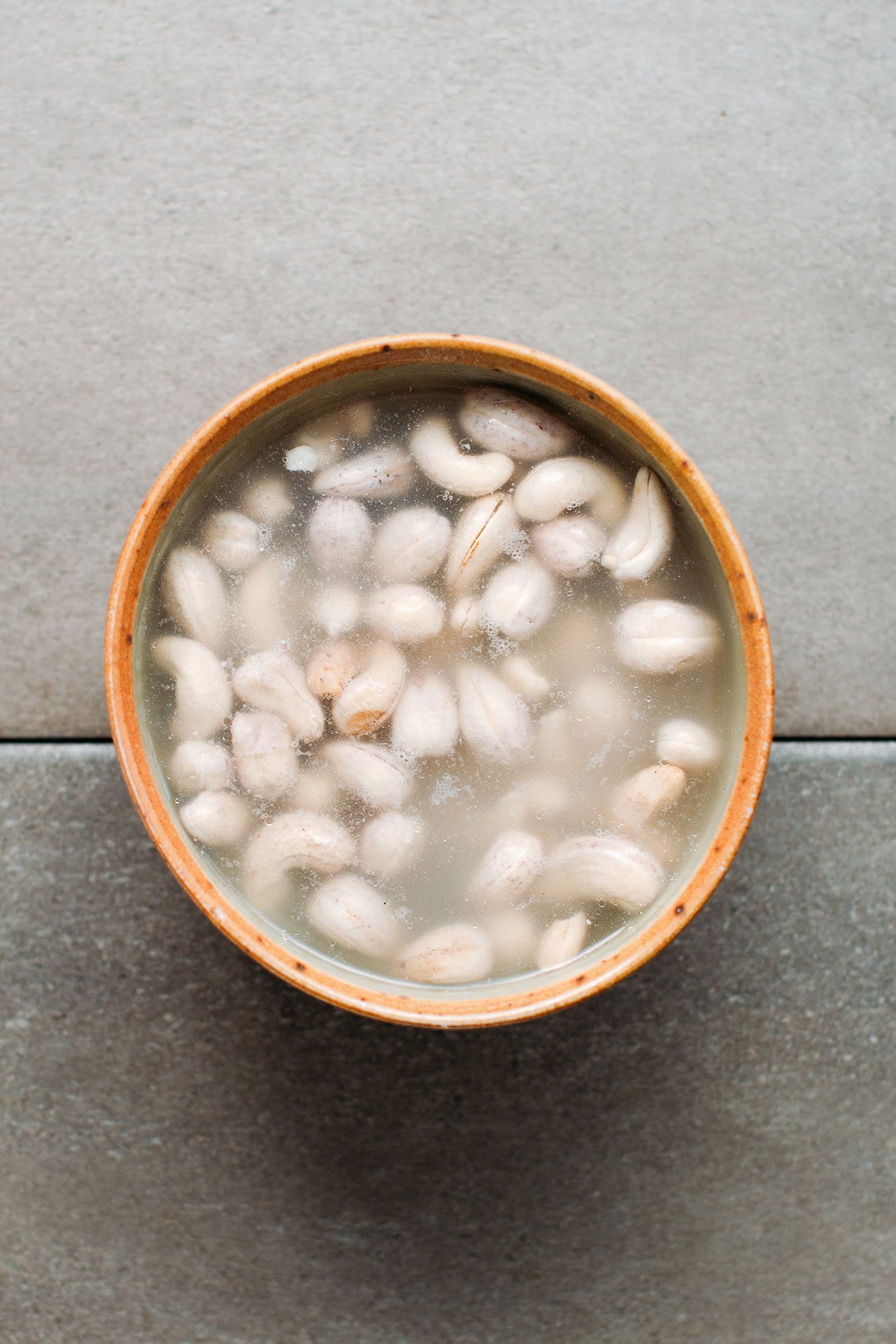
- Blend them into a cream. Next, drain the cashews and transfer them to a high-speed blender. Add the water and blend on high speed for about 30 seconds or until the cashew cream is very smooth.
- Add the probiotics. Transfer the cashew cream to a clean jar or glass bowl. Open the probiotics capsules and add the powder to the cashew cream. Use a wooden spoon to stir well.
2. Let it ferment
- Cover. To prevent the cashew cream from forming a crust on top, place a layer of plastic wrap on top and slightly press it so it is touching the top of the cream.
- Culture it. Let the cashew cream ferment in a dark place, at room temperature, for 12-48 hours. During warm months, the cashew cream just needs about 12 hours to ferment, while in the winter, it can take up to 48 hours. You know the cashew cream is ready when you see small air bubbles have formed. It should have a tangy flavor but should not taste overly sour.
- Refrigerate. Once the cashew cream is done, transfer it to the refrigerator and refrigerate overnight before enjoying it!
📔 Tips
Adjust the consistency.
You can easily adjust the consistency of your cashew cream by increasing or decreasing the amount of water.
For a thick and spreadable cream cheese: use the recommended amount in the recipe. This yields cream cheese that can be spread on toast, used in sandwiches, etc.
For a slightly thinner consistency: add an extra 1/4 cup of water. This will give you a cashew cream that is perfect to use as a dip.
Use a high-speed blender.
I have tried processing the cashews in a food processor, and while it works, it doesn’t yield the best texture. Instead, I highly recommend using a powerful blender. The result will be much smoother with zero graininess.
🌿 Variations
Make a lower-calorie cream cheese: If you want to make a lower-calorie cream cheese, you can blend the cultured cashew cream with an equal weight of silken tofu. Just note that your cream cheese won’t be as tangy.
🥯 Where to Use It
This cultured cream cheese is so versatile! It can be used in:
- Sandwiches or bagels: Use it in place of the mayo in your sandwiches, or spread it on bagels and top with vegan salmon and a sprinkle of scallions.
- Toast: Spread cream cheese on your toast and garnish with either sliced avocado, tomatoes, vegan tuna, or fresh fruits and a drizzle of maple syrup!
- Burgers: To add freshness and subtle cheesiness.
- Mashed potatoes: Incorporate a few tablespoons of cashew cream cheese into mashed potatoes for extra creaminess and a hint of tanginess.
- Casseroles or lasagna: You can combine it with almond milk, nutritional yeast, a dollop of melted butter, and a pinch of nutmeg to make a sauce for gratins or rice casseroles.
🧂 How to Flavor It
Now comes the fun part: flavoring the cream cheese! You can opt for the following:
Original
Simply season with a generous pinch of salt and pepper.
Chives & Garlic
Stir in 1/3 cup of finely chopped chives and 3 cloves of garlic, minced. This one’s perfect for bagels!
Smoky
Add 1/2 tsp of smoked paprika and 1/4 tsp of ground cumin. You can also add a few drops of liquid smoke to make it even smokier. This version works particularly well as a dip or used in wraps.
Seaweed
Stir in 3 tablespoons of finely chopped rehydrated seaweed such as nori or wakame. Sprinkle with toasted sesame seeds and serve it as a dip with French fries or taro fries!
Be creative!
You can also make a chocolate version by adding cacao powder or a cinnamon roll version by incorporating ground cinnamon, raisins, and a drizzle of caramel sauce!
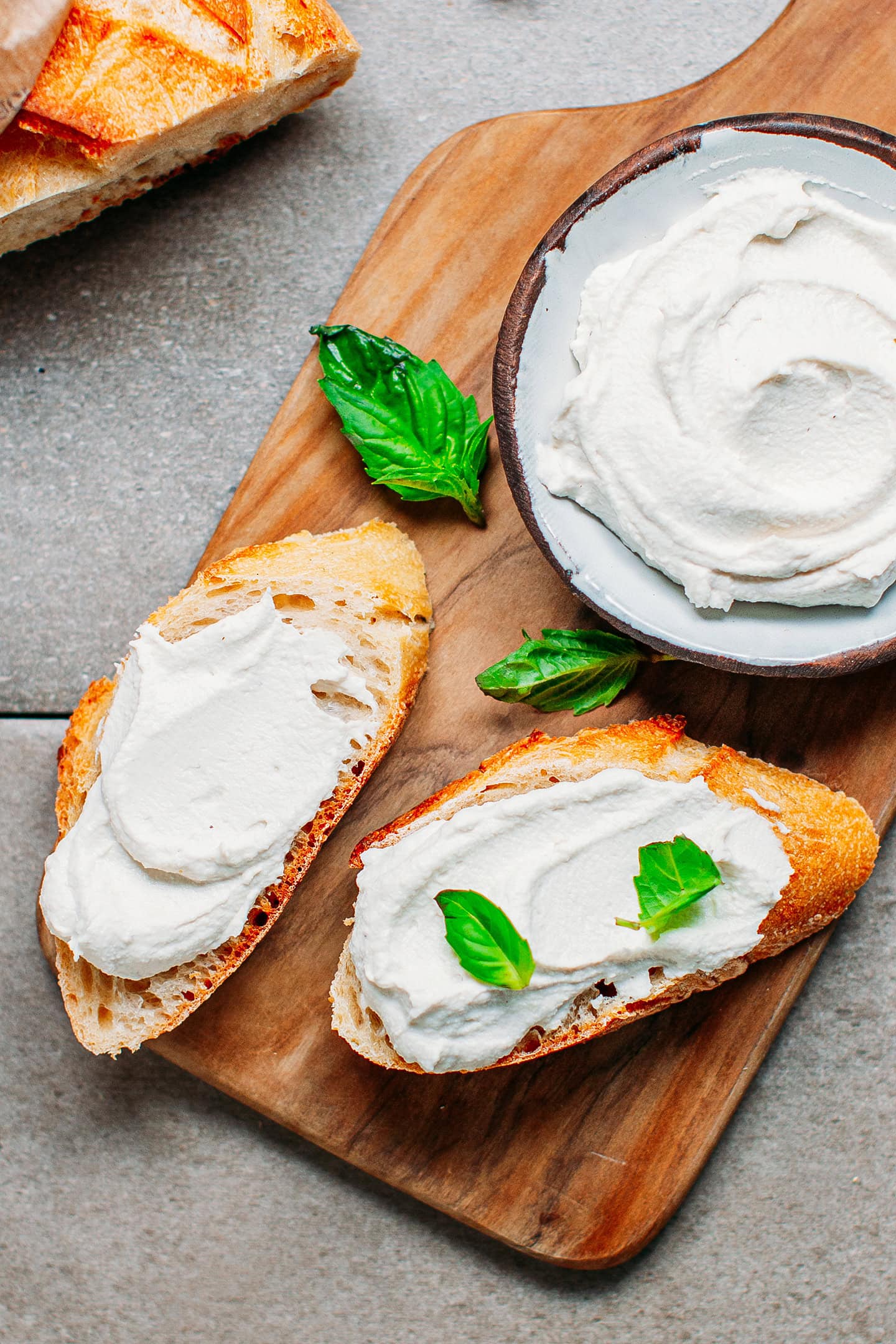
❄️ Storing and Freezing
- To store: You can store the cream cheese in the refrigerator for up to 1 week.
- To freeze: Transfer it to a freezer-safe container and freeze for up to 2 months. Thaw overnight in the refrigerator before using.
💬 FAQ
Yes, if you are in a hurry, you can omit the probiotics and add 3-4 tablespoons of lemon juice or white vinegar. Alternatively, you could replace the water with vegan yogurt. Please remember that your cream cheese won’t taste the same as if it was naturally cultured.
You probably let it ferment for too long or at a too-warm temperature. Next time, let the cream cheese ferment in a colder room or for a shorter period of time.
Depending on the temperature and probiotics used, it can take up to 48 hours for the cream cheese to get a tangy flavor. Let it ferment for another 10-12 hours and taste it.
Unfortunately, I didn’t get good results when trying to make baked cheesecakes using this cream cheese.


Save this recipe!
Enter your email below and I’ll send it to your inbox!
Plus, you will receive new recipes every week!
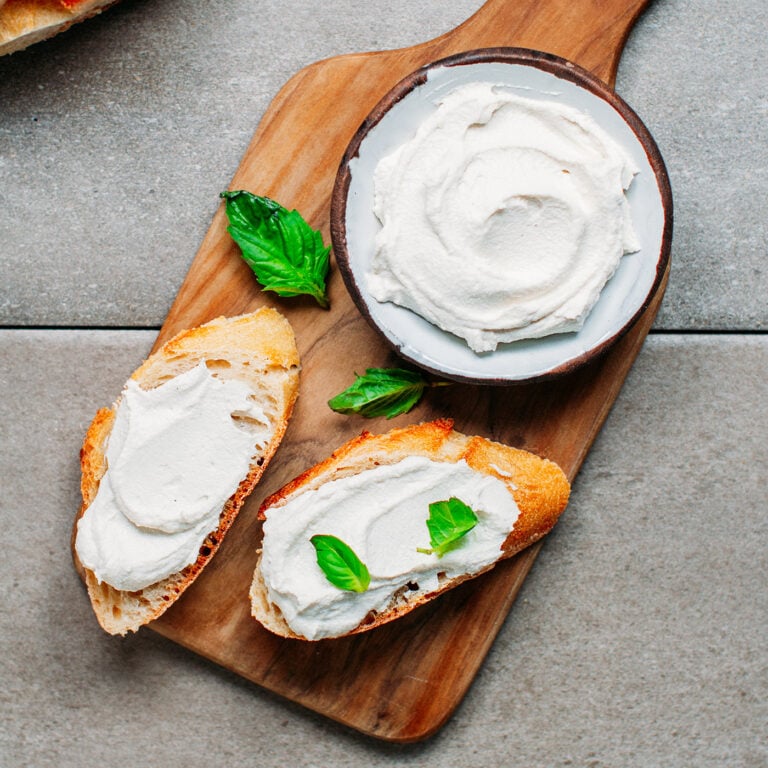
The Best Vegan Cream Cheese
Ingredients
- 2 cups (280 g) raw cashews soaked overnight
- 1/2 cup (120 ml) water
- 2 capsules probiotics I used Solgar's Advanced Acidophilus Plus
- salt to taste
Instructions
Make the cream
- Soak the cashews. Add the raw cashews to a bowl and cover with water. Let them soak overnight or for at least 6 hours. This step softens the cashews and helps get a super creamy texture.
- Blend them into a cream. Next, drain the cashews and transfer them to a high-speed blender. Add the water and blend on high speed for about 30 seconds or until the cashew cream is very smooth.
- Add the probiotics. Transfer the cashew cream to a clean jar or glass bowl. Open the probiotics capsules and add the powder to the cashew cream. Use a wooden spoon to stir well.
Let it ferment
- Cover. To prevent the cashew cream from forming a crust on top, place a layer of plastic wrap on top and slightly press it so it is touching the top of the cream.
- Culture it. Let the cashew cream ferment in a dark place, at room temperature, for 12-48 hours. During warm months, the cashew cream just needs about 12 hours to ferment, while in the winter, it can take up to 48 hours. You know the cashew cream is ready when you see small air bubbles have formed. It should have a tangy flavor but should not taste overly sour.
- Refrigerate. Once the cashew cream is done, transfer it to the refrigerator and refrigerate overnight before enjoying it!
- You can store the cream cheese in the refrigerator for up to 1 week.
Notes
Adjust the consistency.
You can easily adjust the consistency of your cashew cream by increasing or decreasing the amount of water. For a thick and spreadable cream cheese: use the recommended amount in the recipe. This yields cream cheese that can be spread on toast, used in sandwiches, etc. For a slightly thinner consistency: add an extra 1/4 cup of water. This will give you a cashew cream that is perfect to use as a dip.Use a high-speed blender.
I have tried processing the cashews in a food processor, and while it works, it doesn’t yield the best texture. Instead, I highly recommend using a powerful blender. The result will be much smoother with zero graininess.How to Flavor It
Now comes the fun part: flavoring the cream cheese! You can opt for the following: Original: Simply season with a generous pinch of salt and pepper. Chives & Garlic: Stir in 1/3 cup of finely chopped chives and 3 cloves of garlic, minced. This one’s perfect for bagels! Smoky: Add 1/2 tsp of smoked paprika and 1/4 tsp of ground cumin. You can also add a few drops of liquid smoke to make it even smokier. This version works particularly well as a dip or used in wraps. Seaweed: Stir in 3 tablespoons of finely chopped rehydrated seaweed such as nori or wakame. Sprinkle with toasted sesame seeds and serve it as a dip with French fries or taro fries! Be creative: You can also make a chocolate version by adding cacao powder or a cinnamon roll version by incorporating ground cinnamon, raisins, and a drizzle of caramel sauce!Nutrition

About the Author
Thomas Pagot is the founder, photographer, and recipe developer behind Full of Plants. He created the blog in 2016 as a personal cookbook for vegan recipes. Through years of recipe development, Thomas has successfully grown Full of Plants into a trusted resource for plant-based recipes.




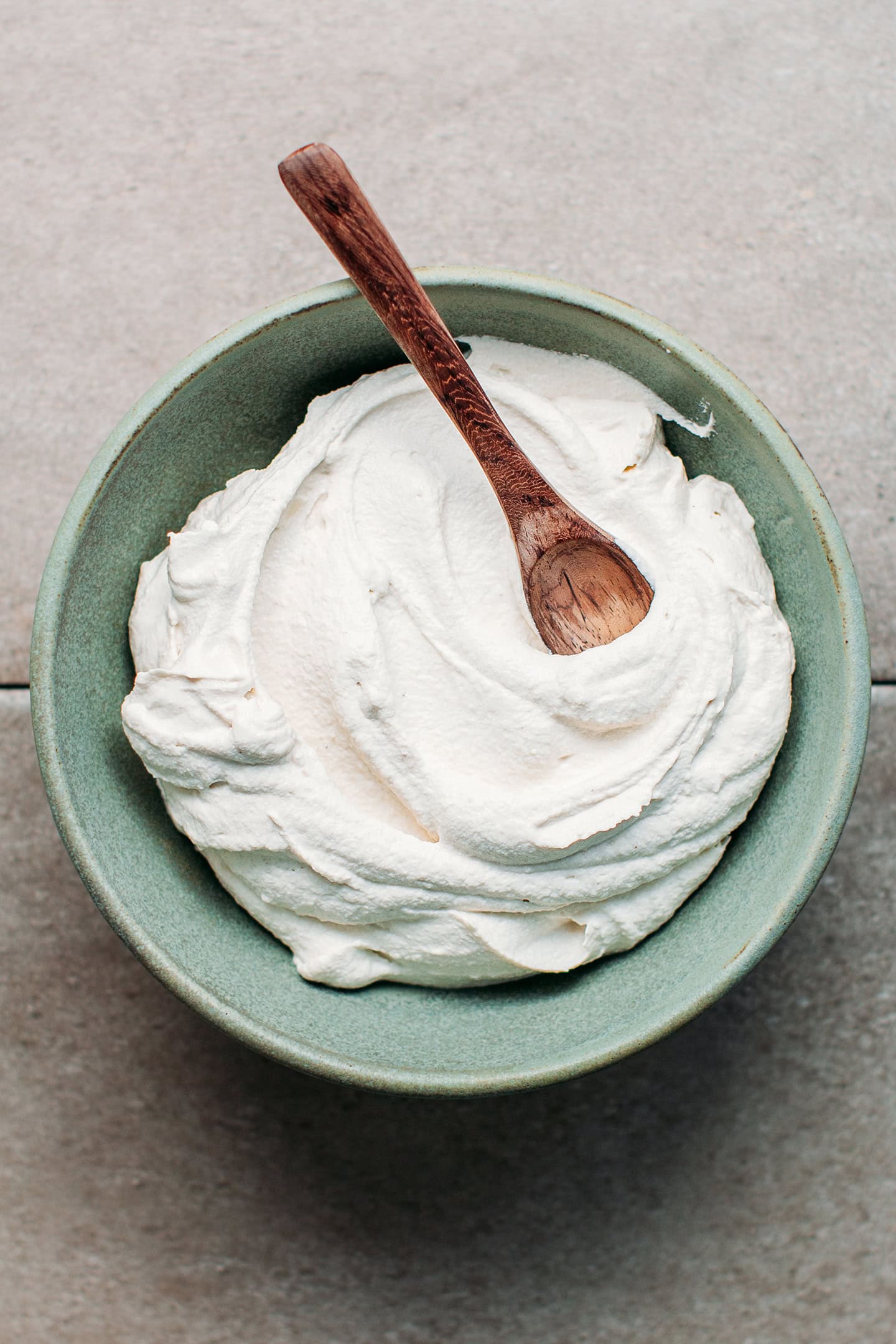
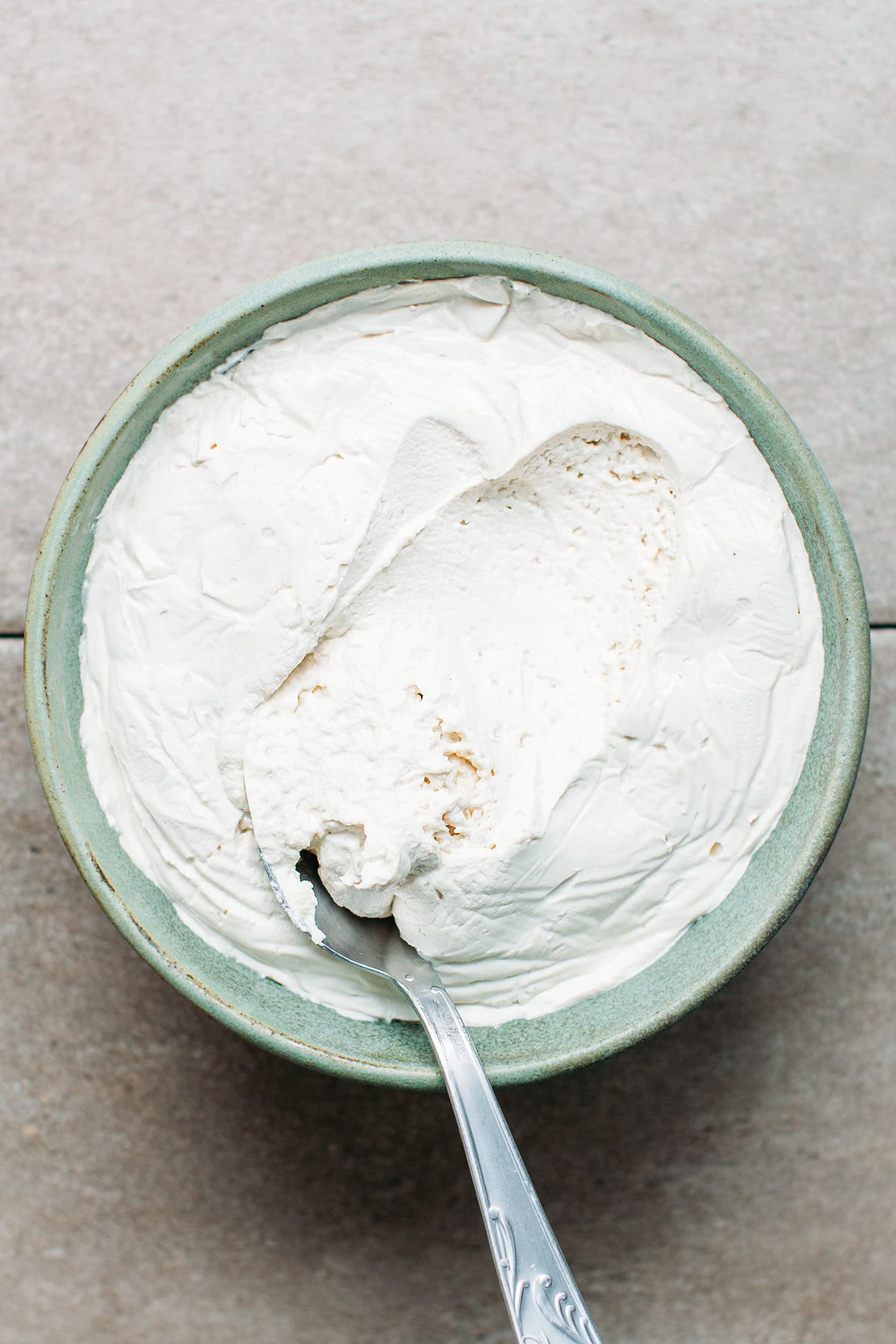

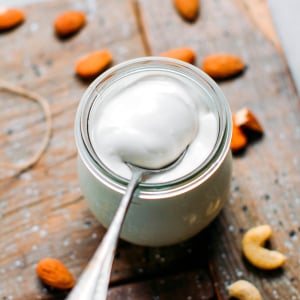

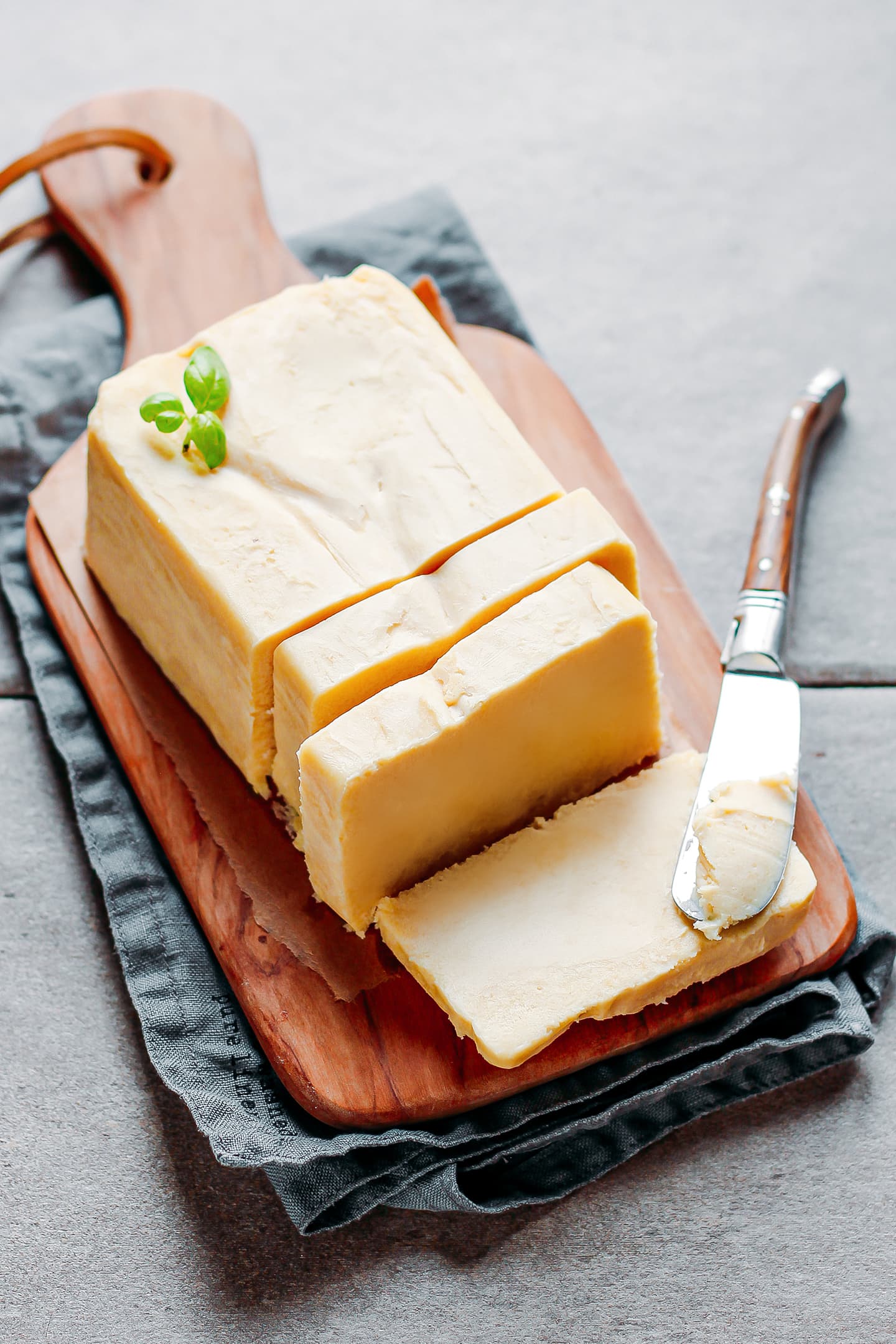
Leave a Comment
Hi Thomas, i had the cheese wait around 24 hrs. Last night it looked alright, but there is a pink layer on the cheese now. I am thinking if this could be the probiotics but would like to ask if you had a guess about it. Thank you!
Hi Deniz,
Pink mold is bad mold I’m afraid. I would not recommend eating this cashew cream. This could be caused by the probiotics (too many or the wrong kind), but most likely it’s because the cashew cream got contaminated somehow. It can be the water you used to blend the cream, a too high temperature, or one of your tool was not completely clean. It’s hard to say and it happened to me as well. I would suggest trying again with boiled water that you let cool down and ensuring that your equipment is as clean as possible.
Stunned! Tastes soo similar to cream cheese.
I compared it directly to an oatly spread one and the difference was very stark.
The fermentation actually made it taste like cream cheese, and suddenly I could taste all the added flavourings in the store bought one.
Used 200 g cashews quickly soaked in boiled water and blended with a little more liquid than instructed.
I subbed the prebiotic capsules with some mesophilic cultures, albeit I used way to much (1 g, oops).
After one night it tasted fairly tangy, but the cashew flavour was still quite strong. My cultures were already expired last year so I was a bit bummed that it might not work out. After a few hours on a very hot day and the night in the fridge it magically turned into tangy, yummy cream cheese!!
Will do again :>
I’m so happy to hear you enjoyed this recipe Jen! You are right, the fermentation is almost magical as it tones down the cashew flavor.
I have noticed too that it tastes even better after resting in the fridge overnight after fermenting.
Thanks for your feedback and rating, I really appreciate it!
I’ve tried others, but they don’t compare to mom’s favorite store-bought. She says this one tastes better! Thanks Thomas!
I’m happy to hear you and your mom enjoyed this cream cheese!
Thanks for your rating!
This recipe is outstanding! Living overseas, I often struggle to find my favorite vegan products, but this recipe completely surpassed my expectations. It is creamier and tastier than anything available in stores.
I’m glad you liked this vegan cream cheese Emy! Thanks for rating it 😉
Perfect!
Thank you Priya!
Beautiful recipe Thomas, thank you. I have made it before with excellent results. Delving into Keto, I thought I’d try it with Brazil nuts. It worked great – soaked as per the recipe and just needed more water to get a smooth consistency (and next time I will blanch the Brazils to remove any brown skin). I let it ferment, and once it was done, I sprinkled in some psyllium husk to thicken it up. It wasn’t overly watery anyhow – and an option was to also strain it through a bag, but I wanted to try the psyllium to see what it did. I found it very successful.
Thanks for your feedback Esther! I am not familiar at all with Brazil nuts, but it’s interesting to hear it works as well!
I’m excited to try this recipe! How much mesophilic culture should I add to this recipe, in place of the probiotics? Also, do you think it would work if I used a combination of macadamia and cashews in this recipe? Thanks!
I would say about 1/16 tsp of mesophilic should be enough.
And a mix of macadamia and cashews should work!
Hi Thomas !
Thank you for this wonderful recipe (and all the recipes on your website !). Never failed me.
I like to experiment so I was wondering if I could do something similar halfway through greek yogurt/cream cheese by straining soy yogurt for 6h then mixing probiotics and let it sit at room temp for 12h.
What do you think ?
Hi Cass,
Thanks for your kind words 😉
Well, I am not sure why you would want to culture yogurt again? Straining the yogurt will give you a thick texture with a tangy flavor already.
I Thomas
in this recipe you use Acidophilus, whereas in the book, you advise Mesophilic.
Which is the difference between them?
Furtermore, I’d like to learn about probiotics. Could you please advise me on a book or something like that where I could increase my knowledge?
Thanks a million.
Ps. I’ve just tried your Creme Caramel…I felt over the moon! I also added a small pinch of tumberic!
Hi Tania,
Mesophilic yields a more buttery, slightly less acidic flavor. Some brands of acidophilus contain too much probiotics (unless you use the one I recommend) and can make the cream turn bad while with mesophilic you won’t have that problem.
Unfortunately I don’t have any book to recommend, I learned most of it online and by testing.
Glad you liked the creme caramel 😉
I’m confused about the winter vs summer portion of the recipe. Indoor temps are the same year round. Is the dish supposed to be placed outside?
No, you should let it ferment indoors at around 68°F (20°C).
Hi! I’m making your ebook cream cheese recipe, and when you say to cover with plastic wrap “to touch”, does that mean to touch it to the surface of the cheese, or the top of the jar? Also with the mesophilic culture, will it work to use 1/4 cup of the fermented cream cheese as a starter (like with yogurt) in subsequent batches? Will I still need to add a little additional culture too? Thanks!!! Julie
Hi Julie,
Yes, I mean the plastic wrap should touch the surface of the cream cheese to prevent it from drying.
I believe using some of the fermented cream cheese as a starter should work without having to add more culture!
Thank you so much! The cream cheese is delicious with the mesophilic culture! I’ve done it with probiotics before, but this culture is new to me. Thank you for sharing all your amazing recipes!
Thanks for your feedback Julie 😉
Hi, two questions; 1-can we add fresh garlic and herbs at the same time with probiotic? or should we add extras including salt after fermenting? 2- which one is better; garlic powder or fresh minced garlic? Thank you!
Hi Afsan,
I would add those after fermenting, to make sure it doesn’t affect the fermentation process. Fresh garlic will yield a nice flavor.
I wanted to thank you for your wonderful recipes. I have used your cashew cream cheese recipe many times and it is wonderful. I used to just soak and then puree cashews and add lemon juice but it never had the tanginess of real cream cheese. Then I downloaded your free cheese book and started using your recipe (with probiotics) of cultured cream cheese. Brilliant! The other day, I accidentally used too much water in blending the cashews but I fermented it anyways and it came out like a lovely crème fraîche. Thanks for all the positivity and wonderful recipes you are sharing on this blog.
Thanks for your kind words Diane! I totally agree, nothing can replace the flavor fermentation brings!
In your camembert recipe you say it’s okay to use mesophilic as a substitute for probiotics. Is it also okay to substitute mesophilic for the probiotics in this recipe?
Yes!
I love this recipe
Can I use this fermented cream to make cheesecakes?
Thank you
Thanks Andrea!
I haven’t tried yet, but I doubt you will get a texture very similar to an authentic cheesecake.
Hello!
I love your recipes, thank you so much for all the work that is behind them.
Regarding the translation into Spanish, I’m from Spain, I speak English and I can do it for free, it would be my pleasure if more people can access this amazing blog.
Cheers;
Erica
Hello Erica,
Thanks for your kind words! We are not looking to translate recipes for now, but thanks for your offer!
Do you think this would work using tofu instead of cashews? Trying to get more soy in my diet. Thank you.
Hi Rebecca,
I haven’t tried but I think using tofu will not yield the same rich and creamy texture. I’m also not sure how it would ferment.
I was wondering if this recipe is the updated version of the cultured cream cheese recipe found in your ebook or simply a different version? I made the cultured cream cheese the other day with mesophilic culture and it turned out amazing! I was totally blown away by how similar to non-vegan cream cheese it was with its tanginess.
Going forward, would you recommend the acidophilus over the mesophilic culture?
It’s not an updated version. Mesophilic culture is not resonating with many people, so to make it simpler I went with probiotics for this recipe.
If you have mesophilic and can find it easily, I definitely recommend it over the probiotics. The flavor is slightly better and more complex in my opinion.
I so agree with this statement. The mesophilic is far superior in taste to me, also.
Awesome The Crazy Vegan luv it thanks for sharing
I have been making fermented cashew cream for years. Sometimes I add coconut milk instead of water. Always wonderful result, perfect for soups or replacing cottage cheese
Thanks for your rating Evva!
Made this and love it. I used a liquid coconut kefir probiotic made in Nova Scotia and there were bubbles within 12 hours. It is tasty as it but I plan to add some herbs to part of the batch for variety.
Awesome! Thanks for your feedback Terri!
Just curious if stirring in the probiotics has to be done with a wooden spoon? Would silicon or metal induce a bad reaction from the bacteria?
I recommend using a wooden spoon just as a precaution, but a few times I stirred using a metal spoon and never had any issue.
Same here, i add probiotics while blending, metal blades but never any issues.
Thus looks interesting. Could I use a little milk kefir instead of probiotic capsule?
Thanks, Elaine
Hi Elaine,
I believe that should work, but I haven’t personally tried.
Fantásticas tus recetas.
Sugerencia:somos muchísimas las personas que te seguimos de habla ESPAÑOLA.
¿Podrías traducir los vídeos de YouTube al
Español? Muchísimas gracias.
Un saludo desde Las Islas Canarias en España.
Hi Valentina,
Thanks for your kind words! Unfortunately I don’t speak Spanish and translating recipes is not planned at the moment.
I made a lot of cashew mass – and then see it keeps only for a week – is it freezable?
Yes, you should be able to freeze it!
Thanks for the recipe. Your recipes are my favourite from the internet. Your vegan fish was sensational.
I wanted to share my tofu fresh cheese with you. It starts with me buying the Chinese 4 litre soy milk. In Vancouver we have a very large Chinese population so that part is easy to find. I buy it because it is much cheaper than buying the two quart SILK or other brand alternative milks. I like soy milk (NON-GMO) best. I also like Almond, but the politics behind Almond milk …. oh never mind. Anyway, I buy 4 litres at a time and often (especially since my son moved out) some of it goes sour. I put the sour milk in a jar, in a hot water bath. within a few hours it has separated. I pour off the whey which I use for many other things… bread liquid, pickling vegetables, etc… the list goes on.
I take the curds and depending on what I want it to taste like, I add lemon juice and nutritional yeast and spread it on crackers, bread, use as dips etc. I almost always have some in the fridge.
You are great!
Jeannie
Thanks so much for your kind words Jeannie!
Natural soy milk is definitely the best, it’s much better than those tasteless commercial brands! Thanks for sharing 🙂
I made this yesterday from the same recipe, different blogger. It is really good. I was surprised.